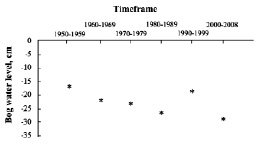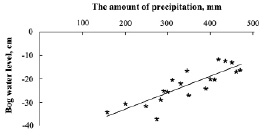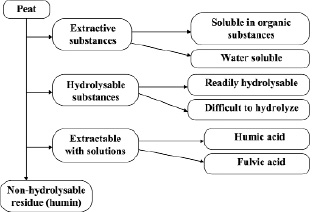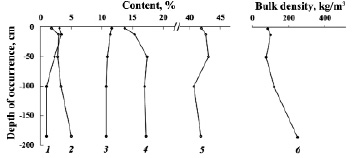The urgency of studying marshes ecosystems of the Northwest Russia is caused by high swamping of the area, as well as significant natural and ecological functions of wetlands. They are a source of raw materials and plant resources, as well as animal habitats, regulating the flow of rivers and serving as a geochemical barrier for various kinds of pollutants [9].
In the Northern Economic Region, Arkhangelsk Oblast has the second highest number of peat deposits and the volume of peat resources, second only to the Vologda region (Table 1).
Table 1
Comparative characteristics of peat resources of the Northern Economic Region [5]
|
Oblast (region) |
Number of deposits |
Peat deposits area of industrial depth, thousand hectares |
Peat resources, million tons |
|
Arkhangelsk |
1917 |
1121,3 |
3750,6 |
|
Vologda |
2376 |
1371,6 |
5573,4 |
|
Karelia |
1299 |
706,1 |
2036,4 |
|
Komi |
1077 |
900,8 |
2685,3 |
|
Murmansk |
782 |
386,2 |
900,1 |
For the protection of peat bog ecosystems, in the allocation it is common to adhere to the following criteria determining the scientific value [5]:
- Natural landscape standards.
- The habitat of rare and endangered species of marsh flora and fauna.
- Research station experimental plots and marshes regime observation points.
Changes of the hydrometeorological regime have been monitored on the oligotrophic bog massifs of the North and the North-West European Russia since the mid-twentieth century [10]. For these observations, a number of bogs was selected, including The Ilas Marshes (64°17′ N, 40°40′ E), situated in the Primorsky district of Arkhangelsk Oblast, where the experimental plot of the Brusovitsa Swamp Station is located.
Oligotrophic boreal bogs are characterized by a convex surface shape, developed microrelief and complex nature of vegetation, with the dominant role of sphagnum. Microlandscapes of the marshes central part are usually presented with ridge-hollow complexes [10].
According to the Brusovitsa Swamp Station data [9, 15], the area of the Ilas Marshes is about 89 km2. Microlandscape of the Ilas Marshes’ central part is a system of oligotrophic ridge-hollow bog complexes (50–60 % of which are occupied by ridges) with bog-hollow central portions (with numerous lakes up to 0,002 km2 and 0,50–2,0 m depth). The vegetation is dominated by sphagnum: cotton grass-shrub with solitary pines (16,3 %), shrub-cotton grass with rare oppressed pine trees (12 %) and pine-cotton grass (10,4 %). Other microlandscapes (such as marsh, moss and forest) occupy smaller areas (2–3 %).
Change of the bog water level is considered the most important in terms of impact on plant associations [10]. The dynamics of these changes for the Ilas Marshes is shown in Fig. 1, where there is a clear trend of increasing depth of the bog water level in the studied period.

Fig. 1. Changing of the bog water level on The Ilas Marshes in the second half of the 20th – early 21st century [1]
Change in the bog water level is largely determined by the type of marsh landscape and climatic factors such as air temperature and the amount of precipitation. Bog water level’s dependence on the amount of rainfall for the Ilas Marshes estimated by Romaniuk K.D. [10] is shown in Fig. 2.

Fig. 2. Bog water level dependence on precipitation (The Ilas Marshes) [9]
Microlandscapes watercut and flowthrough determine the nature of developing vegetation. Items [2, 10] show that violation of bog microlandscape water regime within range exceeding the allowable ecological amplitude leads to a change in plant associations or change of their structure. Eventual drop of groundwater levels typical of the Ilas Marshes (Fig. 1) may lead to the creation of more favorable conditions for the growth and dominance of Sphagnum fuscum and Sphagnum magellanicum [2, 10]. And indeed, according to Churakova E.Yu. [14], the oligotrophic peat bogs of the described territory are characterized by the following types of sphagnum moss: Sphagnum magellanicum, Sphagnum fuscum and Sphagnum angustifolium.
Thus, the Ilas Marshes are a scientific research polygon of the Russian value, where interdisciplinary study is conducted by bog researchers, hydrologists, biologists and ecologists. This area can be considered a representative site for obtaining information about the patterns of peat soils formation in the boreal zone.
The aim of this work is to study the component and elemental composition of peat polymer matrices of the Ilas Marshes bog ecosystems.
Experimental part
Samples of the Ilas Marshes peat at Brusovitsa station were selected by drilling of low water during the summer 2009–2013 from five horizons of the central ridge-hollow swamp microlandscape at the depth of occurrence, respectively: 1 – from 0 to 5 cm, 2 – from 5 to 20 cm, 3 – from 25 to 75 cm, 4 – from 75 to 125 cm and 5 – from 165 to 215 cm.
It was previously established [13] that the moss turf consisting of living sphagnum moss has an average thickness of 6 cm, and its age is about 5 years. In the last 100 years, the average accumulation rate of peat overlying deeper in the section defined in the isotope 210 Pb was 0,17 cm/year.
According to modern concepts [5], the structure of peat can be divided into three phases: solid, liquid and gaseous. Individual solid particles of peat are very diverse in their magnitude, ranging from a few centimeters (plant residues) to a few millimeters, and even smaller particles. It is known that, to a great extent, physical and chemical properties of peat depend on the composition of its individual phases and the quantitative ratios between them [11].
Group composition of organic substances was determined according to the scheme shown in Fig. 3 [11].
Fig. 4 graphically shows the dependence of content of various group components on the peat’s depth.

Fig. 3. Allocation scheme of peat organic matter

Fig. 4. Peat composition dependence on the depth of occurrence: 1 – ash content; 2 – bituminosity; 3 – humidity of air-dried sample; 4 – lignin content; 5 – humic and fulvic acid content; 6 – bulk density
The groundwater level fluctuations area is clearly distinguished at the depth of 50 cm. It is in this horizon that there is a decrease in ash content and water absorption, as well as increased levels of Klason lignin (compounds nonhydrolyzable by acids). However, this trend was not found when analyzing peat bituminosity; at the investigated depth, bitumen content increases smoothly by almost 2 times. Apparently, this is explained by the process of biological degradation of peat polymer matrix macromolecular constituents occurring with the formation of low molecular weight bitumen.
Component and elemental compositions are considered the important characteristics of peat. For a more detailed consideration of peat organic matter component composition formed in the Subarctic climate conditions, the analysis of a sample from the depth of 0,5–0,7 m was performed; its peat polymer matrix has relatively stable physical and chemical properties. Results are presented in table (Table 3).
The data clearly shows that the analyzed peat has an average degree of bituminosity at relatively low ash content (Table 3). Apparently, this is affected by the low «gummosity» peculiar to plants of subarctic region compared to those growing in warmer climates.
Mass fraction of nonhydrolyzable residue (humin) is consistent with other researchers’ data obtained for high peat (Table 2).
Table 2
Peat organic matter group composition
|
Indicator |
Value * |
|
The content of organic matter (OM), % |
|
|
Including % of water-soluble substances incl. polyphenol substances |
1,2 |
|
Bitumen extracted by hexane |
|
|
Ethanol |
|
|
Ethoxyethane |
|
|
Ethyl acetate |
|
|
Biopolymers of humus nature (in the form of humates) Humic acids** |
2,1 |
|
lignin (Klason lignin)*** |
|
|
humin **** |
|
Notes:
* – the numerator contents a range of values; the denominator contains the average value;
** – fraction insoluble at рН = 1‒2;
*** – figure determined in deasphalted sample;
**** – residue after extraction of bitumen and humic acids.
Peat bog ecosystems components are active participants of the carbon cycle as well as its significant reservoirs. Due to possible climate change, the study of carbon balance elements in wetland ecosystems is a particularly acute problem in terms of Euro-Arctic region, where wetlands occupy a vast area (up to 80 %).
However, the studies on the carbon balance of forest and peat bog ecosystems in Russia are few. The elements of carbon balance are best explored in Western Siberia, which is called the waterlogging phenomenon due to the activity of its peat formation processes [3, 4, 7, 8 and 12].
Peat soils element composition of the Ilas Marshes showed that, compared with elemental composition of Siberian peat [6], peat soils of the North are depleted in nitrogen and carbon (С – 43,9 %, О2 – 46,4 %, Н – 5,9 %, N – 0,3 %, others – 3,5 %).
Due to the fact that in ecosystems peat acts as geochemical barrier, it can concentrate a large number of elements – impurities [1]. Background state of peat microelements was assessed by X-ray fluorescence spectroscopy (fundamental parameter method). Analysis of the mean concentrations of elements in peat samples of the Ilas Marshes shows that the iron content varies from 0,3 to 0,9 %, sulfur from 0,3 to 0,6 %, calcium from 0,5 to 0,6 %, magnesium – 0,2 %. The contents of substances relate to toxicant elements, such as strontium, zinc, copper, nickel and manganese ranges from 0,0009 to 0,05 % (Table 3).
Table 3
Microelement content in peat samples of the Ilas Marshes
|
Name of Indicators |
Element content in peat samples of the Ilas Marshes, % |
Name of Indicators |
Element content in peat samples of the Ilas Marshes, % |
|
Titanium |
|
Calcium |
|
|
Strontium |
|
Potassium |
|
|
Bromine |
|
Chlorine |
|
|
Zinc |
|
Sulfur |
|
|
Copper |
|
Phosphorus |
|
|
Nickel |
|
Silicon |
|
|
Iron |
|
Aluminum |
|
|
Manganese |
|
Magnesium |
|
|
Chrome |
|
Sodium |
|
|
Mercury [9] |
|
Titanium |
|
In their paper, Ovsepyan A.E. and others [9] found that the mercury content in the Ilas Marshes soils varied within 0,009–0,06 µg/g, with an average of 0,027 µg/g (0,000027 %). The highest concentrations of mercury are associated with soil horizon of 0,5 cm, relatively low ones – with the horizons 0,5–20 cm. The authors argue that the impact of the Arkhangelsk agglomeration and atmospheric transport of air masses on mercury contamination of soil samples is insignificant; mercury concentration in the soils under study is at the background level.
Diagram illustrating the resource potential structure of the Ilas Marshes peat is shown in Fig. 5.
Thus, the high peat of the Ilas Marshes is versatile both in terms of macromolecular humates green reagents extraction and biologically active low molecular substances (such as waxes, resins), as well as in terms of implementation of the calorific value of peat due to its low ash content.
The authors are grateful for the warm welcome and the assistance provided by the employees of Brusovitsa Swamp Station and its Head, Rastorguyeva N.V.; the employees of IEPN of the Ural Branch of RAS: Larionov N.S., Candidate of Chemical Sciences, Ulyanovskiy N.V., Junior Research Scientist, Khviyuzov S.S., Candidate of Chemical Sciences, and Kuznetsova I.A., Junior Research Scientist, for assistance in sampling peat during field work, as well as the staff at Arktika Center for Collective Use of Scientific Equipment (Northern (Arctic) Federal University named after M.V. Lomonosov) Pochtalova A.S., Candidate of Chemical Sciences, and Malkova А.V., Candidate of Chemical Sciences, for their help in the study of peat elemental composition.

Fig. 5. Peat resource potential of The Ilas Marshes
The studies were performed with the support of inter-regional and inter-departmental Basic Research of UB RAS (project № 12-C-5-1017), the Russian Foundation for Basic Research (RFBR project № 12-03-90018-Bel_a), the Foundation for Basic Research RB (project FFI RB X 12R-147), the oriented fundamental research of UB RAS 12-5-3-008-ARKTIKA and the RAS Presidium Program № 4 (project № 12-P-1021-5), using the equipment provided by Arktika Center for Collective Use (Northern (Arctic) Federal University named after M.V. Lomonosov) and the Center for collective use of Critical Technology RF-Arktika, (IEPS and IFPA of UB RAS).






























